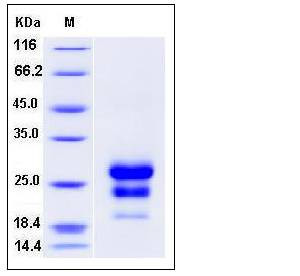Human CLEC4D / CLECSF8 Protein (His Tag)
CLEC-6,CLEC6,CLECSF8,MCL,MPCL
- 100ug (NPP2024) Please inquiry
| Catalog Number | P11485-H07H |
|---|---|
| Organism Species | Human |
| Host | Human Cells |
| Synonyms | CLEC-6,CLEC6,CLECSF8,MCL,MPCL |
| Molecular Weight | The recombinant human CLEC4D consists of 180 amino acids and has a calculated molecular mass of 21.2 kDa. In SDS-PAGE under reducing conditions, rhCLEC4D migrates as several bands with apparent molecular mass of 21-27 kDa due to different glycosylation. |
| predicted N | His |
| SDS-PAGE |  |
| Purity | > 92 % as determined by SDS-PAGE |
| Protein Construction | A DNA sequence encoding the human CLEC4D (NP_525126.2) extracellular domain (Gly 52-Asn 215) was expressed, with a polyhistidine tag at the N-terminus. |
| Bio-activity | |
| Research Area | Immunology |Signal Transduction |Cytoskeleton / ECM |Cell Adhesion |Lectin |C-tyep lectin | |
| Formulation | Lyophilized from sterile PBS, pH 7.4 1. Normally 5 % - 8 % trehalose and mannitol are added as protectants before lyophilization. Specific concentrations are included in the hardcopy of COA. |
| Background | C-type lectin (CLEC) family is a type of carbohydrate-binding protein domain named lectin. C-type lectins are the most diverse and prevalent lectin family in immunity with its requirement for calcium for binding. Proteins including a C-type lectin domain have diverse range of functions including cell-cell adhesion, immune response to pathogens and apoptosis. There are at least 14 types of C-type lectins: typeⅠto typeⅩⅣ. CLEC4D(CLECSF8) is a typeⅡ membrane glycoprotein belonging to the C-type lectin family, with restricted expression in the monocyte/macrophage lineage. It plays important roles in the function of macrophages. |
| Reference |
